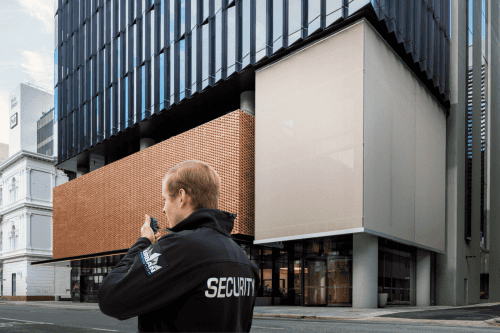How to Solve Common Physical Security Problems

In today’s ever-changing business environment, ensuring physical security is essential for protecting employees, customers, and assets. Below, we explore the most common physical security problems faced by businesses and practical solutions to address them effectively.
1. Theft and Burglary
Theft and unauthorised access are ongoing risks for businesses, often targeting valuable assets, equipment, or sensitive documents. Theft of physical records, in particular, poses unique challenges as it compromises sensitive business information and can lead to legal or reputational repercussions.
Solutions:
- Install or upgrade access control systems, such as key cards or biometric locks, to restrict entry. Outdated systems are prone to failures, creating opportunities for unauthorised access.
- Deploy anomaly detection cameras to identify unusual patterns of activity or behaviour, adding a proactive layer of monitoring to detect and prevent potential threats early.
- Use CCTV cameras to monitor critical areas and deter intruders.
- Engage security guards to oversee access points, patrol vulnerable areas, and respond swiftly to suspicious activity. Our comprehensive reporting system ensures incidents are logged in real-time or summarised in detailed 24-hour reports, providing actionable insights for business operations.
2. Vandalism
Vandalism, which includes graffiti, property damage, or destruction of equipment, not only causes financial loss but also harms a business’s professional image.
Solutions:
- Build perimeter fencing to establish clear boundaries and protect vulnerable areas.
- Improve security lighting around your premises to deter potential vandals.
- Employ security guards to conduct regular patrols and maintain a visible presence, discouraging vandalism through deterrence.
3. Workplace Violence
Workplace violence can stem from misunderstandings or external pressures, posing risks to safety, productivity, and morale across industries. Whether in office settings, hospitality venues, or industrial worksites, high-pressure tasks or large groups can sometimes escalate into confrontations.
Solutions:
- Deploy trained security guards to monitor high-risk areas, de-escalate tensions, and ensure the safety of employees and visitors.
- Use strategically placed surveillance cameras to deter incidents and support investigations.
- Collaborate with security teams to establish and practise clear protocols for managing incidents effectively.
4. Tailgating and Unauthorised Entry
Tailgating occurs when an unauthorised individual follows an authorised person into a restricted area, bypassing access controls.
Solutions:
- Install turnstiles or security doors that allow only one person to enter at a time.
- Educate employees to identify and report tailgating incidents.
- Use visitor management systems to track and control external access to restricted areas using Licence Plate Recognition technology (LPR).
- Station security guards at critical checkpoints to actively monitor and stop tailgating attempts in real time.
- Deploy intelligent surveillance systems, such as anomaly detection cameras, to flag unusual entry behaviours automatically and alert security teams.
5. Unaccounted Visitors
Visitors who are not properly logged or tracked can become a significant security risk, especially when there is no record of their activities.
Solutions:
- Implement electronic visitor management systems to log and monitor visitors in real-time.
- Issue temporary visitor badges to clearly identify authorised visitors and restrict their access.
- Position security guards at reception areas to greet visitors, verify credentials, and ensure unauthorised individuals are denied access.
- Partner with a security provider offering comprehensive customised reporting systems to identify any unaccounted visitors, ensuring greater oversight and accountability.
6. Stolen Identification
Lost or stolen identification cards, key fobs, or credentials can allow unauthorised individuals to gain access to sensitive areas, posing a significant security risk.
Solutions:
- Use multi-factor authentication (e.g., combining biometrics with ID cards) to make stolen credentials less effective.
- Regularly audit access logs and deactivate lost or stolen IDs immediately.
- Assign security guards to verify identification visually at sensitive areas, adding an additional layer of security.
7. Social Engineering
Social engineering involves manipulating individuals into giving away confidential information or allowing unauthorised access. Attackers may pose as employees, visitors, or service providers to exploit human error.
Solutions:
- Conduct regular training sessions to educate employees on recognising and responding to social engineering tactics.
- Establish a verification process for service providers or external personnel requesting access to facilities.
- Use security guards to verify on-site personnel and escort unauthorised individuals off the premises if required.
8. Cyber-Physical Attacks
The growing integration of technology in physical security systems—such as surveillance cameras and electronic locks—makes them vulnerable to cyber attacks.
Solutions:
- Regularly update software for all security systems to address vulnerabilities.
- Segment networks to ensure critical physical systems are isolated from broader business networks, limiting exposure.
- Employ security guards trained in recognising signs of tampering with physical equipment, such as cameras or access systems.
Security guards play a crucial role in addressing modern physical security threats. From deterring theft and vandalism to managing emergency situations and verifying visitor credentials, their presence provides a dynamic, responsive layer of protection that technology alone cannot achieve.
At Urban Protection Group, we provide expert security personnel and tailored solutions designed to address the diverse physical security needs of Australian businesses. Contact us today to learn more about how we can secure your business’s future.
